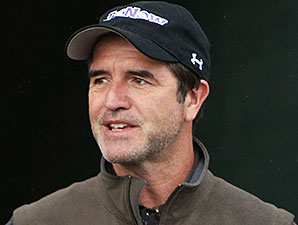A Few Questions With Keith Desormeaux


Originally published in the Nov. 20 edition of Blood-Horse Daily. To download the Blood-Horse Daily smartphone app or to receive the edition in your inbox each evening, visit BloodHorse.com/Daily.
Today's MarketWatch interview is with trainer Keith Desormeaux, who has found success buying and training stakes winners such as Texas Red, Ive Struck a Nerve, Right There, Swipe, and Exaggerator, the morning-line favorite for the Nov. 21 Delta Downs Jackpot (gr. III).
Blood-Horse Daily: You're known for finding nice stakes horses for budget prices. How would you describe what you look for?
Keith Desormeaux: I've never been the type of guy who's had a big budget, but I've never considered that a crutch. For (an owner) to honor me with confidence to go to a yearling sale and buy him a potential nice horse, I always consider that gratifying and fun.
But the only way you can really know what it takes to find a good horse is to be along for the ride with young horses all the way (through their careers). There are so many changes a horse goes through as you start to put the workload on that young, immature body of theirs. Through years (of training), you've got to figure out what kind of body type it takes to withstand the training.
I don't care who they're by and out of; none of that matters if they don't have balance, conformation, and athleticism. We do that first: analyze a horse for those three things and then we delve into the pedigree. I try to find a depth of class within that pedigree without glaring stakes winners in the first dam. If the dam is a graded stakes winner and the resulting foal is by Tapit , well, I don't care what he looks like; I can't afford him.
BHD: What are some conformational or veterinary issues that you're willing to deal with?
KD: I love when consignors say "sesamoiditis." I love when they say "a small chip in the back ankle," or "chips" anywhere. I love when they say "OCDs" because the price is going down and everybody's running scared. If the horse is balanced, has good conformation, and athleticism, I could care less what those (vet) reports say. The more on the report, the better for me because I know I'm getting a deal.
I have my ways, and they work for me, but I certainly understand these guys out there spending $200,000 up to $1 million on a horse. You can't be telling a client, "I don't care that he has sesamoiditis and a chip in the right ankle, we're still going to buy him for a million." I don't think I could do that myself if someone came up to me and said spend $1 million on this horse that has a chip somewhere. It'd be kind of tough for me to spend that money in good conscience.
BHD: Is it true you hadn't laid eyes on Exaggerator or Texas Red before they walked into the back ring at Keeneland September?
KD: That's correct. It doesn't take long to see a good horse. It's fine to spend time at the barns in the morning, but there's a good reason (why I look in the back ring)—those horses get pretty pumped up in the afternoon during the sale, which can be likened to a race. They do not show the same characteristics at the barn in the morning. I want to see what I'm going to be looking at in the paddock in eight more months, and you only get that look in the sales ring.
